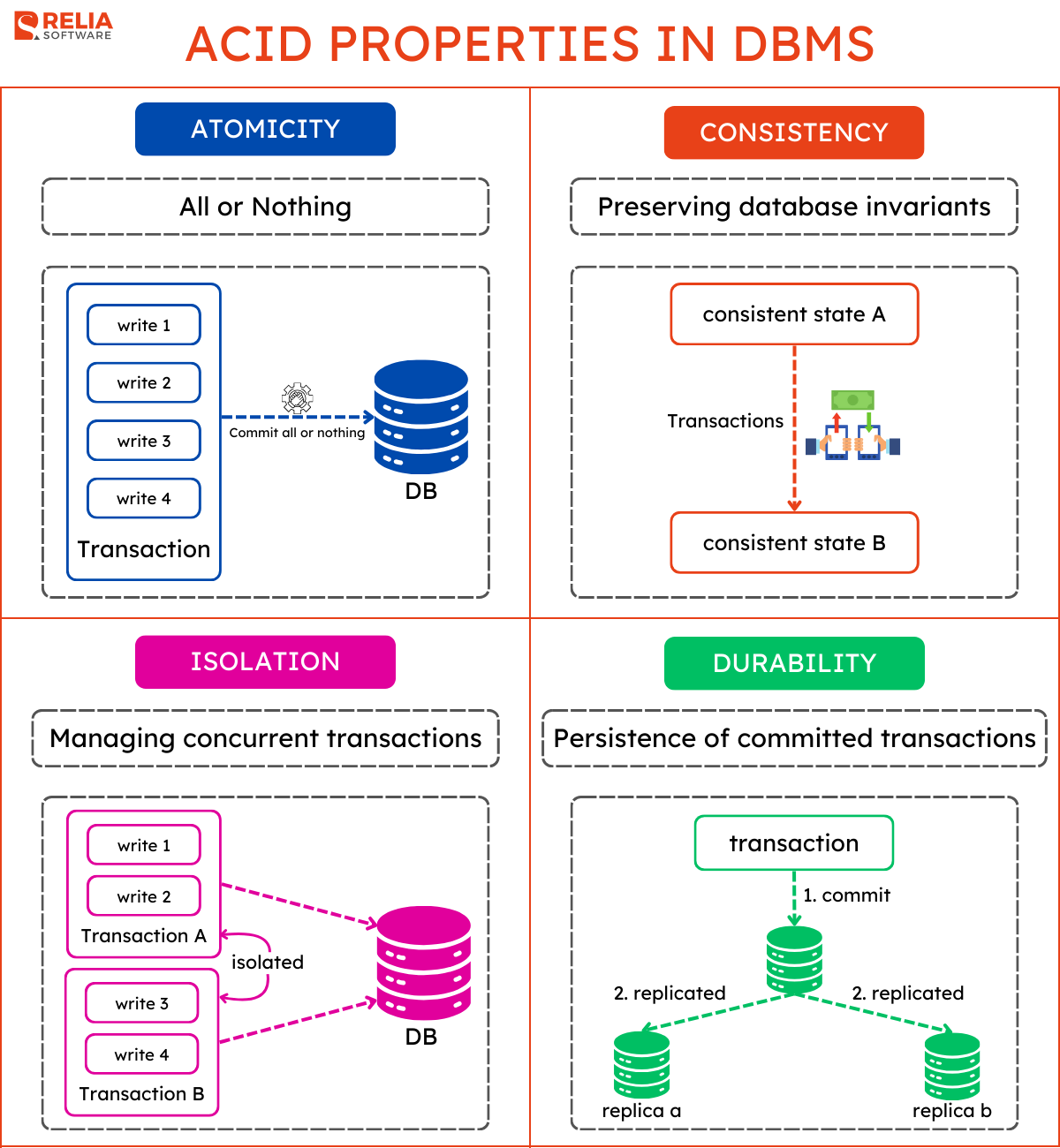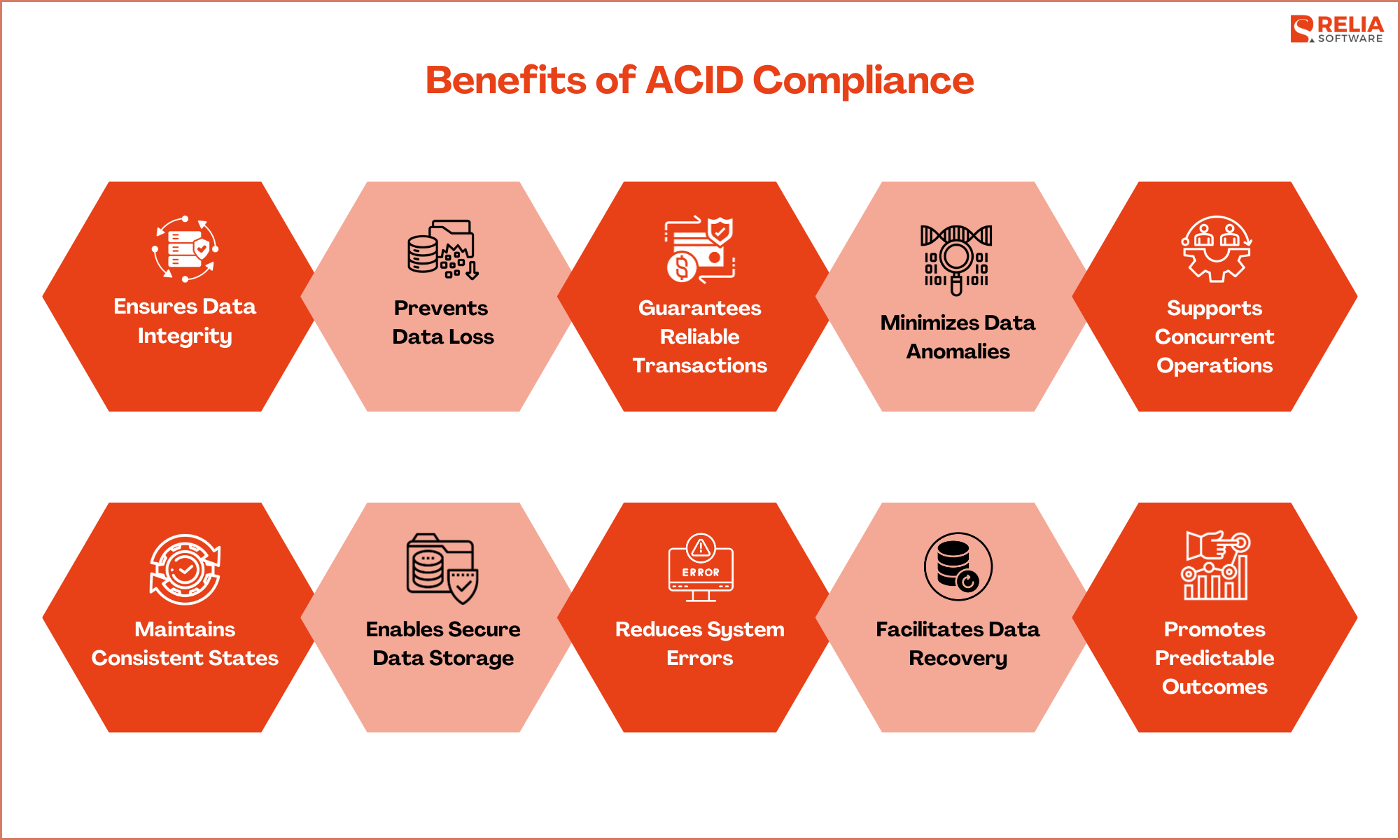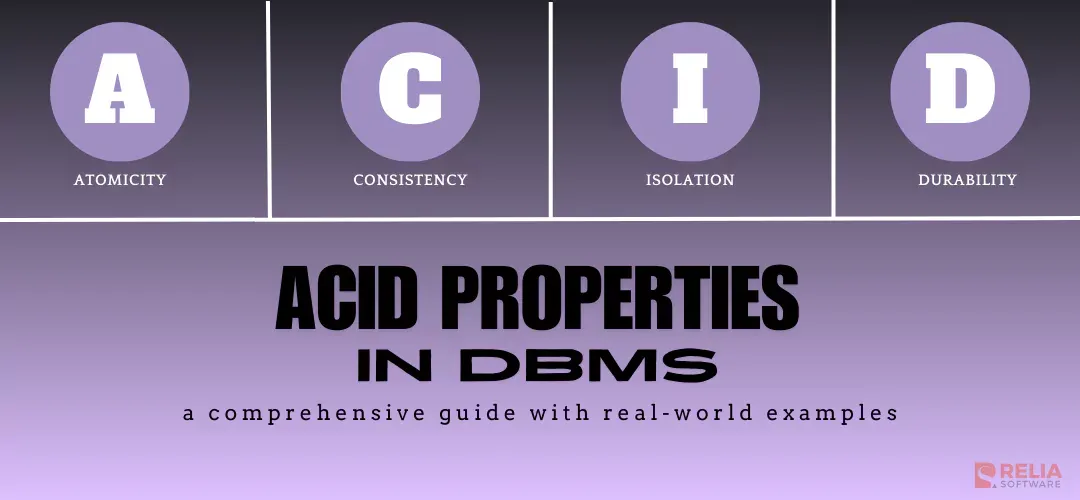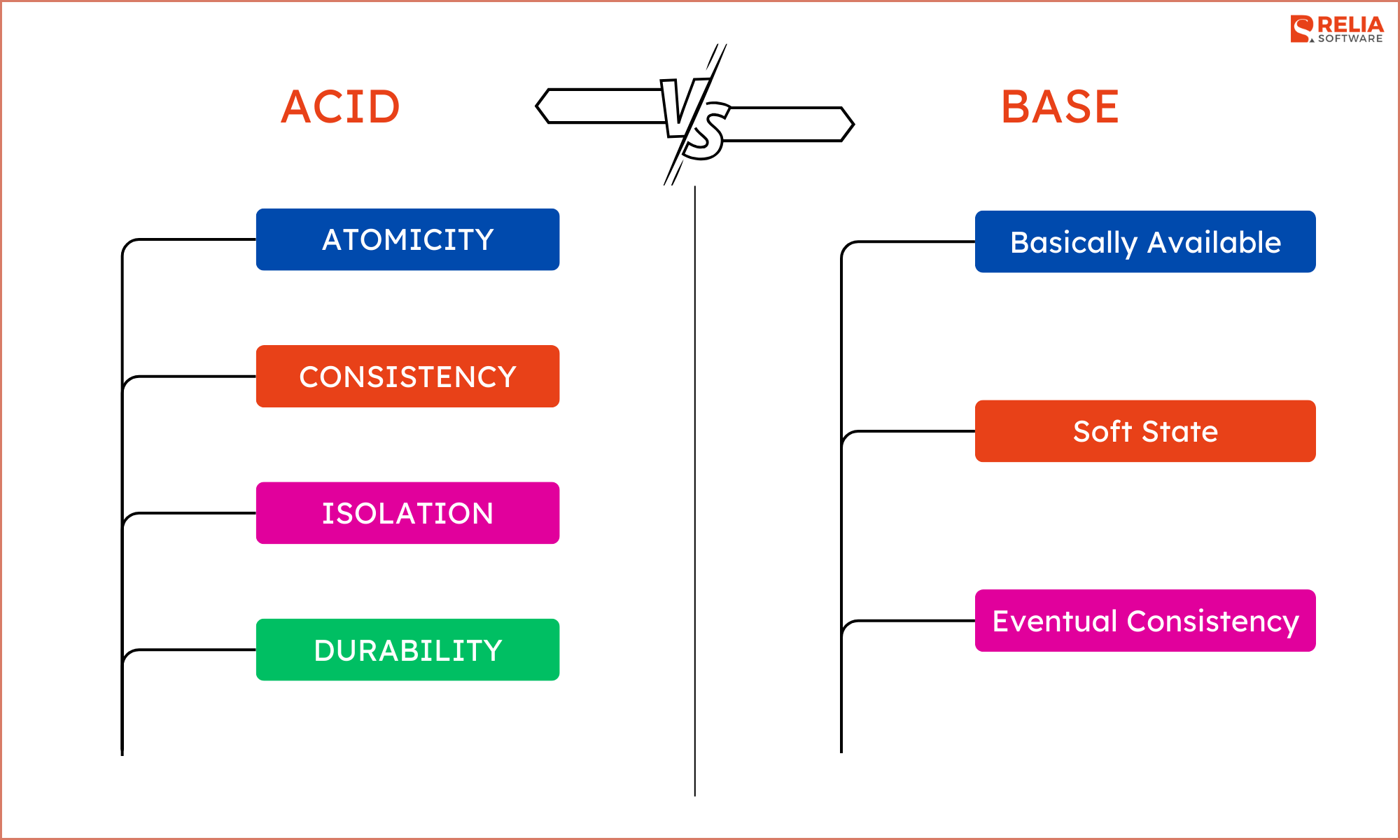In database management systems (DBMS), ensuring data reliability and integrity is crucial, and the ACID properties—Atomicity, Consistency, Isolation, and Durability—are fundamental to achieving this. This article breaks down each property, explaining how they contribute to accurate transaction processing and consistent data management. We'll also explore real-world examples of ACID properties in DBMS, compare them with alternative models, and emphasize their critical role in industries like banking and e-commerce, where maintaining data integrity is essential.
>> Read more:
- Database Scaling Explained: A Guide to Efficient Growth
- Mastering Index in SQL to Improve Database Performance
- Understanding 6 Different Types of Indexes in SQL
What are ACID Properties in DBMS?
ACID stands for Atomicity, Consistency, Isolation, and Durabilityy, which are the fundamental principles that ensure the reliability and integrity of database transactions. A transaction, in this context, refers to a series of operations executed as a single, indivisible unit of work. The ACID properties ensure that these transactions maintain the database’s stability, even in cases of errors, system crashes, or other unexpected failures.
First introduced in the early 1980s by computer scientists Theo Härder and Andreas Reuter, the ACID framework defines the essential requirements for processing transactions in a secure and predictable manner. Each property plays a critical role in this process, which we will explore in detail in the next section.
These properties are particularly vital in relational databases, where strict data accuracy and reliability are necessary. ACID properties are the foundation for applications that manage sensitive and high-value data, such as banking systems, e-commerce platforms, and other industries that rely on precise transaction management to maintain operational integrity.
Detailed Explanation of 4 ACID Properties in DBMS
Atomicity
- Definition: "All or nothing" principle
Atomicity ensures that a transaction is treated as a single, indivisible unit. This means that either all operations within the transaction are completed, or none are applied. If any part of the transaction fails, the entire transaction is aborted, and the database remains unchanged.
- Real-world example: Bank transfer between accounts
Consider a bank transfer where money moves from Account A to Account B. The transaction has two critical steps:
-
- Debiting Account A: Subtracting the amount from Account A.
- Crediting Account B: Adding the same amount to Account B.
Atomicity guarantees that both operations occur together or not at all. If the system fails after debiting Account A but before crediting Account B, atomicity rolls back the transaction, preventing any loss of funds.
- Technical implementation: Achieving atomicity in databases
Databases use mechanisms like transaction logs and rollback processes to maintain atomicity:
-
- Transaction Logs: Changes are recorded in a log before execution, which allows the database to undo or redo actions if needed.
- Rollback Mechanisms: If a transaction fails, the database uses the log to reverse any partial changes, restoring the database to its previous state.
Consistency
- Definition: Ensuring data validity after a transaction
Consistency ensures that a transaction moves the database from one valid state to another, adhering to rules, constraints, and integrity checks. It guarantees that any changes must comply with the database’s validation rules.
- Example: Enforcing data integrity constraints
Suppose the database has a rule that an employee’s salary cannot be negative. If a transaction attempts to set a salary to a negative value, the consistency property will prevent this change, ensuring the database remains in a valid state.
- How consistency relates to database schemas and rules?
Consistency is tied to:
-
- Database Schemas: Defines structures, data types, and relationships between tables.
- Constraints and Rules: Enforces integrity through primary keys, foreign keys, unique constraints, and checks.
- Triggers and Stored Procedures: Automated scripts that run under certain conditions to maintain consistency.
Isolation
- Definition: Managing concurrent transactions
Isolation ensures that transactions occurring at the same time do not affect each other. Each transaction should run as if it’s the only one operating, preventing issues from simultaneous access.
- Explanation of isolation levels
Isolation levels determine the degree of separation between transactions:
-
- Read Uncommitted: The lowest level; transactions may read uncommitted changes (leading to dirty reads).
- Read Committed: Transactions can only access committed data, avoiding dirty reads but allowing non-repeatable reads.
- Repeatable Read: Ensures consistent reads during a transaction, preventing non-repeatable reads but not phantom reads.
- Serializable: The highest level; fully isolates transactions, preventing dirty reads, non-repeatable reads, and phantom reads by locking data.
-
Example: Two transactions accessing the same account balance
Imagine two transactions happening at the same time:
-
- Transaction 1: Reads the balance of Account C ($1,000) and plans to withdraw $200.
- Transaction 2: Reads the balance of Account C ($1,000) and plans to deposit $300.
Without proper isolation:
- Both transactions read the same initial balance ($1,000).
- Transaction 1 writes a new balance ($800).
- Transaction 2 writes a new balance ($1,300), overwriting Transaction 1’s update.
Proper isolation ensures that one transaction completes before the other modifies the same data, resulting in the correct balance ($1,100).
Durability
- Definition: Persistence of committed transactions
Durability guarantees that once a transaction is committed, it remains so, even if a system crash or power outage occurs. Changes made are permanently recorded.
- Example: System crash recovery and data retention
For instance, if a customer places an order on an e-commerce site and the transaction commits just before a crash, durability ensures that when the system restarts, the order remains in the database.
- How databases ensure durability?
Databases use techniques such as:
-
- Write-Ahead Logging (WAL): Before changes are made, they’re recorded in a log stored on stable storage like disks or SSDs.
- Checkpointing: Periodically saves the database state to stable storage, enabling recovery to a known state.
- Redundant Storage Systems: RAID configurations or distributed storage minimize data loss from hardware failures.
In case of failure, the database uses transaction logs and checkpoints to restore committed transactions, ensuring data integrity.

How ACID Properties Prevent Data Anomalies?
ACID properties protect data from common issues that arise during transaction processing, especially in multi-user and concurrent environments:
Dirty Reads
A dirty read happens when a transaction reads data modified but not yet committed by another transaction. If the first transaction rolls back, the read data becomes invalid.
Prevention: Isolation levels like Read Committed ensure transactions only access committed data, preventing dirty reads.
Non-Repeatable Reads
In a non-repeatable read, a transaction reads the same data twice, but another transaction modifies it in between, leading to different results.
Prevention: The Repeatable Read isolation level locks the data, preventing other transactions from modifying it until the initial transaction is complete.
Phantom Reads
A phantom read occurs when a transaction retrieves rows based on a condition, but a subsequent query in the same transaction shows new rows inserted by another transaction that meet the same condition.
Prevention: The Serializable isolation level locks the dataset, ensuring no new data is inserted until the transaction completes.
Lost Updates
Lost updates occur when two transactions simultaneously update the same record, causing one update to overwrite the other without knowledge of the changes.
Prevention: Isolation mechanisms ensure one transaction finishes before another can modify the same data, preventing such conflicts.
Benefits of ACID Compliance in Critical Systems
ACID compliance is crucial for systems where data integrity and reliability are essential. The key benefits include:
- Data Integrity and Accuracy: ACID properties ensure that transactions are processed reliably, keeping data accurate and consistent. This is especially important in sectors like banking, healthcare, and transportation, where even minor data errors can have severe consequences.
- Error Prevention: By enforcing atomicity and consistency, ACID-compliant systems prevent partial or invalid transactions, reducing the risk of data corruption and anomalies.
- Concurrent Access Management: Isolation allows multiple users to access the database simultaneously without interference, ensuring smooth operations and a positive user experience while maintaining data integrity.
- Reliable Recovery: Durability guarantees that committed transactions are permanently recorded, even in the event of system failures, ensuring critical applications remain robust and dependable.
- Regulatory Compliance: Many industries require strict adherence to data integrity standards. ACID compliance helps organizations meet these legal and regulatory requirements, supporting safe and secure data handling.

Examples of Real-World Applications Requiring Strict ACID Compliance
Healthcare Management Systems
Healthcare databases handle sensitive patient information, like medical records, prescriptions, and billing. It’s vital to maintain ACID compliance to keep this data accurate, consistent, and secure, especially to meet regulatory standards like HIPAA.
- Atomicity: Ensures that updates to a patient’s medical record (e.g., adding a diagnosis and prescribing medication) are completed as a single unit. If one part fails, the entire transaction is rolled back.
- Consistency: Ensures that all medical records adhere to rules (e.g., validating that prescribed medications do not conflict with known allergies).
- Isolation: Prevents different departments or doctors from overwriting each other’s updates, ensuring patient records stay accurate.
- Durability: Guarantees that once an update is made, it’s saved and remains intact, even if there’s a system crash.
Example: When a doctor updates a prescription, the system makes sure the change is fully saved so other healthcare providers see the latest information right away.
>> Read more: Data Security in Healthcare Software: Why Is It Important?
Retail Inventory Management Systems
Retail systems track product availability, manage stock levels, and handle restocking across stores. ACID compliance is crucial to keep inventory data accurate, ensuring that products are available when customers need them.
- Atomicity: Makes sure that when inventory is updated (e.g., after a sale or restock), the whole process happens as one unit. If anything goes wrong, the update is canceled.
- Consistency: Keeps stock levels accurate by enforcing rules (e.g., not allowing sales if stock is zero).
- Isolation: Prevents simultaneous updates to inventory levels, ensuring that only one transaction can adjust stock for a specific item at a time.
- Durability: Confirms that once inventory is updated, the information stays secure, even if the system encounters issues.
Example: When several customers try to buy the last unit of a product simultaneously, the system uses isolation to ensure only one transaction updates the inventory, avoiding overselling.
Manufacturing Control Systems
Manufacturing systems manage assembly lines, inventory use, and quality checks. ACID compliance is necessary to log operations correctly and keep everything coordinated to minimize errors and keep production running smoothly.
- Atomicity: Ensures that when a new batch starts, all related actions (e.g., using materials and logging production) happen together. If any step fails, the whole operation is rolled back.
- Consistency: Makes sure that processes follow the correct rules (e.g., checking inventory before starting production).
- Isolation: Ensures that simultaneous operations on different parts of the production line do not interfere with each other.
- Durability: Ensures that once production data is recorded, it’s saved permanently, even if the system goes down unexpectedly.
Example: When a production line begins a new batch, the system tracks each material as it's consumed and logs each product as it's made, ensuring all data matches the real-time process and is safely stored.
ACID in Popular Databases
Many modern databases implement ACID properties to varying degrees. Here’s how ACID properties are applied in some of the most popular databases:
MySQL
MySQL is a widely-used relational database that supports ACID properties, particularly when using storage engines like InnoDB:
- Atomicity: Transactions are either fully completed or reversed using transaction logs.
- Consistency: Enforces rules like foreign keys and unique keys to keep data valid.
- Isolation: Offers several levels, like Read Committed and Serializable, to manage how data is accessed and modified simultaneously.
- Durability: Uses a write-ahead logging (WAL) system to make sure changes are saved, even after a crash.
PostgreSQL
PostgreSQL is known for its strong support of ACID properties and advanced transaction features:
- Atomicity: Uses Multi-Version Concurrency Control (MVCC) to manage transactions and allow rollbacks.
- Consistency: Enforces rules such as foreign keys and primary keys to ensure data remains correct.
- Isolation: Supports various levels like Repeatable Read and Serializable to prevent issues like phantom reads.
- Durability: Uses WAL to ensure transaction logs are written before data changes are saved.
Microsoft SQL Server
ACID properties in SQL Server are implemented by its robust transaction management system:
- Atomicity: Uses transaction logs to ensure operations are completed fully or reversed if needed.
- Consistency: Maintains data integrity with rules like constraints and triggers.
- Isolation: Provides levels from Read Uncommitted to Serializable, offering flexibility for different performance needs.
- Durability: Logs transactions before changes are applied to secure committed data.
Oracle Database
Oracle Database provides comprehensive ACID support for critical applications:
- Atomicity: Uses undo logs for rollback capabilities if a transaction fails.
- Consistency: Enforces rules to validate data during transactions.
- Isolation: Supports isolation levels like Serializable, using MVCC for consistent reads.
- Durability: Redo log files ensure changes are saved and recoverable, even during crashes.
MongoDB
MongoDB, a NoSQL database, supports ACID more fully in recent versions:
- Atomicity: Ensures operations on a single document are either fully applied or rolled back.
- Consistency: Maintains consistency within individual documents since it doesn’t use traditional relational constraints.
- Isolation: Isolates changes at the document level; newer versions support multi-document transactions for more isolation.
- Durability: Uses journaling to write changes to disk, ensuring data is safe once committed.
>> Read more:
- What is a Graph Database? Benefits, Use Cases & Examples
- Vector Database vs Graph Database: Which One Is Better?
ACID vs BASE Properties in Database: What is the Difference?
ACID and BASE represent two different approaches to database management, each with its strengths and trade-offs. Let's compare them:
| Aspect | ACID | BASE |
| Stands for | Atomicity, Consistency, Isolation, Durability | Basically Available, Soft State, Eventual Consistency |
| Consistency Model | Strict consistency; always consistent post-transaction | Eventual consistency; becomes consistent over time. |
| Availability | May reduce availability for consistency. | Prioritizes availability over immediate consistency. |
| Transaction Model | Fully compliant, ensuring complete transactions or none. | Allows partial failures for availability and speed. |
| Scalability | Vertical scaling; horizontal scaling is complex. | Horizontal scaling; easily handles more nodes. |
| Performance | Higher latency due to strict controls. | Lower latency; optimized for speed under heavy loads. |
| Use Cases | Banking, finance, inventory management. | Social media, web caching, online retail. |
| Complexity in Distribution | Requires complex protocols (e.g., two-phase commit). | Simpler to implement; handles node failures well. |
| Data Integrity | High integrity; transactions are fully reliable. | Lower short-term integrity; resolves inconsistencies gradually. |
| Failure Handling | Rollbacks and recovery for stability. | Tolerates failures; inconsistencies resolved over time. |
| Database Examples | MySQL, PostgreSQL, Oracle | Cassandra, DynamoDB, Apache Kafka |
Trade-offs and Challenges with ACID Properties
ACID properties are crucial for maintaining data integrity, but they come with significant trade-offs and challenges, especially in distributed and high-performance environments.
Performance Overhead
Ensuring ACID compliance adds processing steps that can slow down databases:
- Latency: Protocols like transaction logging and synchronization increase delays, which can be problematic for real-time or high-load systems.
- Reduced Concurrency: High isolation levels prevent data conflicts but limit how many transactions run simultaneously, affecting throughput.
- Lock Contention: Locking mechanisms used for isolation can lead to bottlenecks, deadlocks, and reduced performance in high-concurrency environments.
Scalability Challenges
Scaling ACID-compliant systems horizontally across distributed environments is complex:
- Coordinated Transactions: Distributed systems need protocols like Two-Phase Commit (2PC) to maintain consistency, which can slow down performance due to network latency.
- Network Delays: Achieving immediate consistency across nodes can be impractical, particularly in geographically dispersed systems, impacting scalability and speed.
- CAP Theorem: Enforcing strong consistency may require sacrificing availability or partition tolerance, limiting system scalability.
Resource and Cost Implications
ACID properties increase resource use and hardware demands:
- Locking Overhead: Transactions often compete for access to the same resources, leading to delays and reduced throughput.
- Hardware Needs: Ensuring durability and recovery (e.g., logging) requires more powerful hardware, raising costs and limiting the use of affordable options.
- Recovery Mechanisms: Ensuring durability requires sophisticated processes like write-ahead logging and checkpoints. While these protect data integrity, they consume significant resources and can slow down the system during heavy write operations.
Adaptability with Modern Data Models
- Rigid Structures: Traditional ACID systems often struggle to handle the diverse and changing data models found in modern databases, like those used in NoSQL.
- Lack of Flexibility: The strict consistency rules of ACID don’t align well with the flexible, schema-less setups that are common in many of today’s distributed systems.
Strategies to Mitigate ACID Challenges
To manage the complexities of maintaining ACID properties, several strategies can be employed:
Relaxing ACID Properties:
- Eventual Consistency: Adopting eventual consistency in parts of the system can enhance scalability and performance when immediate consistency is not essential.
- Adjusting Isolation Levels: Using lower isolation levels (e.g., Read Committed) instead of Serializable can reduce locking and improve concurrency.
Using Distributed Transaction Protocols:
- Optimistic Concurrency Control: Minimizes locking by assuming transaction conflicts are rare and validating before commit.
- Conflict-Free Replicated Data Types (CRDTs): Enable concurrent updates without conflicts through data structures that merge changes deterministically.
Partitioning Data:
- Sharding: Divides data across nodes based on a key to reduce cross-node transactions and enhance scalability.
- Data Localization: Stores related data together on the same node to minimize the need for distributed transactions.
Employing Hybrid Database Systems:
- NewSQL Databases: Provide ACID compliance with improved scalability, blending SQL's consistency with NoSQL’s flexibility.
- Multi-Model Databases: Support various data models and consistency levels within a single system, offering adaptability for different application needs.
Designing for Idempotency and Compensating Actions:
- Idempotent Operations: Ensure repeated actions yield the same result, simplifying retries without adverse effects.
- Saga Pattern: Decompose long-running transactions into smaller, compensable actions to manage them efficiently in distributed systems.
Practical Scenarios Where ACID Compliance is Challenging and Suitable Solutions
Maintaining ACID properties in certain real-world scenarios can introduce significant complexities. In some cases, relaxing ACID properties may provide a more efficient solution. Below are examples of these scenarios and the trade-offs involved.
Global Transactions Across Multiple Datacenters
- Scenario: Financial institutions processing transactions across different regions must coordinate operations across multiple datacenters.
- Challenges:
- Network Latency: Large geographic distances cause delays, making it difficult to synchronize transactions in real-time.
- Partition Tolerance: Network issues between datacenters can disrupt transaction completion, affecting system availability.
- Strict Consistency Requirements: Enforcing consistency across regions may lead to sacrificing availability, violating service level agreements (SLAs).
- Solution: Eventual Consistency
High-Throughput E-commerce Systems
- Scenario: Online retail platforms, especially during peak times like flash sales, must manage thousands of transactions per second.
- Challenges:
- Lock Contention: High isolation levels may cause inventory records to lock, leading to delays and reduced throughput.
- Performance Overhead: Maintaining ACID compliance during high traffic increases overhead, potentially slowing down transaction processing.
- Scalability Limits: Scaling to accommodate increased load while ensuring strict consistency can be costly and technically complex.
- Solution: Eventual Consistency
Microservices Architecture with Distributed Databases
- Scenario: Applications built with microservices often involve multiple services, each with its own database, requiring transactions to span different services.
- Challenges:
- Complex Transaction Management: Coordinating transactions across microservices and databases introduces complexity.
- Two-Phase Commit (2PC) Limitations: Using 2PC can cause blocking and delays, which conflicts with the need for high availability and responsiveness in microservices architectures.
- Failure Handling: Managing partial failures across distributed services complicates maintaining atomicity and durability.
- Solution: Saga Pattern
Real-Time Data Processing Systems
- Scenario: Stock trading platforms and similar systems require real-time processing of trades with strict consistency and low latency.
- Challenges:
- Latency Sensitivity: The overhead involved in ensuring ACID compliance can introduce unacceptable delays.
- Concurrency Control: High levels of concurrent transactions increase the risk of contention and deadlocks.
- Scalability Needs: These systems must handle traffic spikes without sacrificing consistency.
- Solution: Weak Isolation Levels
Internet of Things (IoT) Applications with Edge Computing
- Scenario: IoT systems collect data from numerous sensors distributed globally, requiring aggregation and processing in real-time.
- Challenges:
- Intermittent Connectivity: Edge devices may have unreliable connections, making it hard to maintain consistent state.
- Distributed Data Sources: Synchronizing and aggregating data from numerous nodes is complex.
- Resource Constraints: Limited processing power and storage on edge devices make full ACID implementation challenging.
- Solution: Eventual Consistency
Conclusion
The ACID properties—Atomicity, Consistency, Isolation, and Durability—are essential for maintaining data integrity and reliable transactions in databases. They are crucial in fields like banking, finance, and healthcare, where data accuracy is critical. While ACID compliance can create performance and scalability challenges, especially in distributed systems, it provides a strong defense against data corruption.
For developers and database admins, prioritizing ACID compliance is key when data integrity cannot be compromised. This involves optimizing transactions, choosing the right isolation levels, and implementing error handling. However, when performance and scalability take priority and slight inconsistencies are acceptable, relaxing some ACID properties in DBMS may be the best approach. The key is finding the right balance to meet both reliability and performance needs.
>>> Follow and Contact Relia Software for more information
- Mobile App Development
- Web application Development
- development


